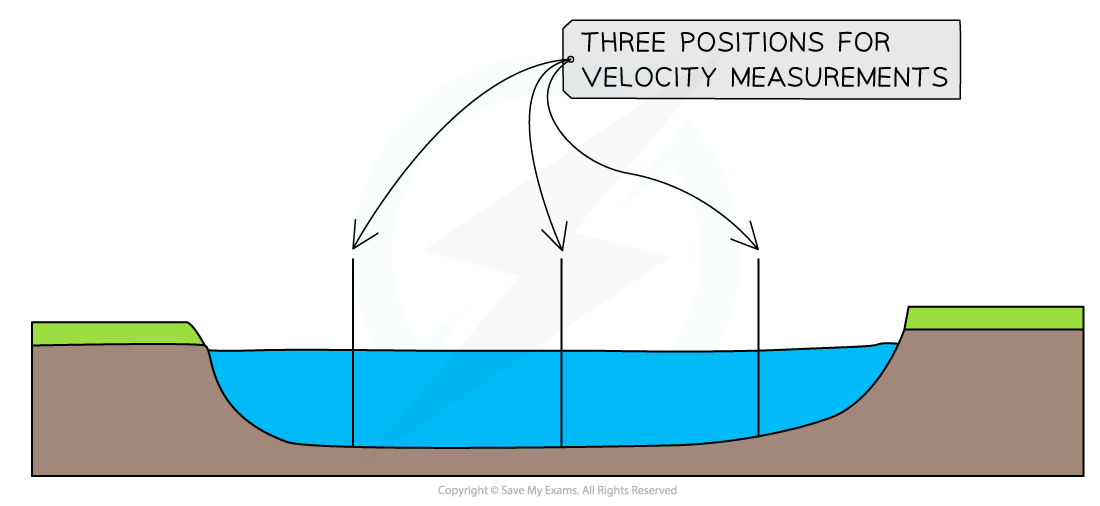River Practical Skills
River Fieldwork Enquiry
- To undertake a river fieldwork enquiry there are a range of practical skills and methods that will be used
- These can be applied to any river fieldwork
- The fieldwork enquiry should be linked to geographical theory
- In the river fieldwork enquiry the Bradshaw model is usually used

The Bradshaw Model
Aims and Hypothesis
- The aims and hypothesis come from questions asked about the river such as:
- Does discharge increase along the length of River Y?
- Does the average velocity increase along the length of River Y?
- How and why does the cross profile change along the long profile of River Y?
- Examples of an aim would be:
- An investigation into how a river's cross-profile changes downstream
- An investigation into changes in discharge with distance downstream
- Examples of a hypothesis would be:
- The width and depth of River Y will increase with distance downstream
- The discharge of River Y increases with the distance downstream
- After the aims and hypothesis of the fieldwork have been established the next steps include:
- Selecting the sites - this will involve sampling
- Deciding on the equipment to be used
- Considering any health and safety issues - completing a risk assessment
- Data collection method
Worked example
(i) Suggest one possible aim of a river channel investigation (2)
- Answer: This should be an aim, not a hypothesis so should outline what the enquiry/investigation is attempting to achieve
- To investigate the changes in velocity (1) with increasing distance from the source (1)
- To investigate the changes in channel cross-profile (1) with increasing distance from the source (1)
- An investigation into changes in river discharge (1) after confluences within the river (1)
(ii) Identify three reasons why a river channel investigation may not achieve the aim given in (i) (3)
- Answer:
- Data inaccurate (1)
- Insufficient data collected (1)
- Inaccurate data analysis (1)
- Human errors in data recording (1)
- Aim not practical (1)
- Unsuitable sites selected (1)
Site Selection and Sampling
- To collect data it is not practical to measure all parts of the river
- To select the river sites sampling should be used to reduce bias
- There may be situations where access to the river is limited meaning an opportunistic approach to sampling may need to be taken. However, this should be as close as possible to the site selected using sampling
- The most commonly used sampling strategies for a river enquiry are:
- Systematic - a sampling of sites at regular intervals mean that all parts of the river are covered
- Random - the use of random sampling means that all sites have an equal chance of being selected which eliminates bias
- Stratified - by sampling sites immediately downstream of a confluence significant changes in discharge can be identified
- Site location can be recorded using GPS to give an accurate location using latitude and longitude
Worked example
Suggest which sampling method would be appropriate to use in a river channel investigation (3)
- Answer:
- Systematic because measuring at regular intervals (1) ensures that no parts of the river are missed (1) and it reduces bias (1)
- Random because using a random number generator (1) means all sites have an equal chance of being selected (1) which means that there is no bias (1)
Equipment
- To complete the river measurements a range of equipment is needed
- The equipment includes the following:
- 25+ meter tape to measure the river width and for marking out distance downstream for velocity measurements
- 1-metre rule for measuring the depth
- Clipboard for holding recording sheets
- Pencil for writing in data
- Camera to take photographs of sites and river features
- Float or flowmeter for measuring velocity
- Stopwatch if not using a flowmeter
Worked example
Identify a suitable piece of equipment to measure river velocity (1)
| A Anemometer | |
| B Quadrat | |
| C Clinometer | |
| D Stopwatch |
- Answer:
- D (1) - Stopwatch which is used to time how long it takes a float to cover a specified distance
Risk Assessment
- Any fieldwork will involve consideration of health and safety using a risk assessment
- Risks associated specifically with river fieldwork may include:
- Weather conditions
- Slippery rocks
- Polluted water
- Working in an unfamiliar place
- Misuse of equipment
Worked example
A group of students has investigated the changes in a river channel shape.
State one risk that the students might identify in their risk assessment (1)
- Answer: Any one of the following would be acceptable
- Slip or fall (1)
- Infection from dirty water (1)
- Flash flooding (1)
- Weather conditions (heavy rain/sun) (1)
Suggest one way the risk stated could be managed (1)
- Answer: This should follow from the answer above
- Sturdy/suitable footwear e.g. walking boots (1)
- Wash hands/use antibacterial hand wash/cover cuts and wounds (1)
- Do not enter the river after heavy rainfall (1)
- Check the weather forecast before going out to collect fieldwork data (1)

 Measurement of River Width
Measurement of River Width Depth Measurements
Depth Measurements 
